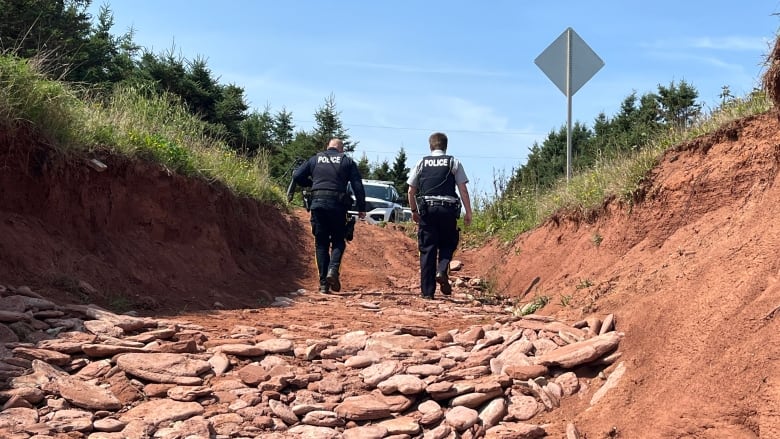P.E.I. violent crime rate jumps 16%, once more above the national average
Bad behaviour online seems to be spilling onto the street, says criminology professor

A big increase in the violent crime rate on P.E.I. in 2023 pushed it significantly above the national average for the first time in almost 20 years.
The rate increase is partly due to a continuing trend of more crime happening through the internet, but there was also a big increase in assaults, which had been on a downward trend.
Violent crime rates fell across Canada in the early years of this century, bottoming out around 2015, when they began climbing again.
This pattern was exaggerated on P.E.I. In 2003, the number of violent crimes per 100,000 population was 1,819.65, well above the national rate of 1,434.79. But the Island rate began to fall rapidly, crashing to 749.24 in 2015. The national rate was also falling, but its low point was 1,044.23.
Both rates turned around about that time, but P.E.I's climbed more steeply, reaching the national average again in 2019. It stayed around the national level during the pandemic, but in 2023 the ratejumped 16.1 per cent in a single year. At 1,605.41, it was 12 per cent above the national average.
Those more dramatic changes are not unexpected when measuring a smaller population, said Simon Fraser University criminology Prof. Martin Andresen, because it takes fewer incidents to make a change in the rate.

"It's consistent with the rest of the country," said Andresen."You don't see the big jumps on the national level that you do with a smaller province like P.E.I., just because it takes a lot more to move the national numbers over time."
But that is not to say there's nocause for concern.While rates are still lower than they were 20 years ago, they are trendingupward.
Crimes through the internet
The overall trend in crime over the last 20 years follows a simple down and up curve, but a look at which particular crimes are more and less frequent reveals a very complicated picture.
Excluding theft and mischief, for virtually all of this century, and likely throughout the last century as well, the most common criminal offence on P.E.I. has been assault, Level 1, also referred to as simple or common assault.This offence covers a wide variety of actions, from aggressive behaviour to physical contact, but generally does not include physical injury.
But in 2021, the rate of this level of assaulton P.E.I. was surpassed by the rate for fraud, and fraud held that position in 2022 and 2023.
The growth in fraud was part of a trend incrime facilitated by the internet, often perpetrated against Islanders by people who don't live in the province.
That included crimes such as extortion, almost non-existent on P.E.I. from 2006 to 2012 before growing exponentially in the last few years. The rate almost doubled in 2023, up to 52.36 incidents per 100,000 residents.
Other crimes usingthe internet, some of which may be chalked up to local perpetrators, are also rising.
Uttering threats, criminal harassment and indecent/harassing communications have doubled in prevalence since 2017. Complaints about non-consensual distribution of intimate images, which became a crime only in 2015, rose from a rate of 2.77 incidents per 100,000 people in that year to 23.59 (from 4 to 41 cases) in 2023.
Changes in assault cases
Up until 2022, that appeared to be the main part of the story when it came to how violent crime rates were rising, but the 2023 figures seem to show crime shifting back to the street as well.

While the rate of Level 1 assaults remained lower than the fraud rate last year, it did rise by22.5 per cent. There was also a big increase in more serious assaults. Level 2 assaults, those involving a weapon or bodily harm, were up 28.9 per cent.
Level 1 assault rates were higher at the turn of the century. The rate hit 528.23 incidents per 100,000 population last year, but it hovered above 600 from 2002 to 2004.
Recent rates for more serious assaults have been higher than those turn-of-the-century levels, though.
The average rate from 2001-05 for Level 2 assaults was 61.45, but in the last five years that rate grew to 81.96, which is 33 per cent higher.
Level 3or aggravated assault in which victims are wounded, scarred, maimed, disfigured or left with life-threatening injuries remains rarewith fewer than 10 cases a year. Still, the 3.50 average rate during the last five yearswas 72 per cent higher than the 2.04 average rate P.E.I. recorded from 2001-05.
'A tipping point'
Martin Andresen sees this change as online behaviourspillingover into real life.
"We've hit some kind of a tipping point," he said."There's been a change in the way we interact with one another.
"The interactions online have changed. People are horrible to one another when they don't have to look at one another, and I think we're starting to see some of this moving into public spaces."
He believes some of that changeis driven by desperation: The impact of the COVID pandemic, the inflation spike that followed it, and the pressures placed on P.E.I. society by a rapidly growing populationare starting to show up in crime rates.
"People are struggling. The social contract that we end up having to be civil to one another ends up breaking down," he said.

Andresensaid that trend is showing up across the country.
"Violence has gone up. There's no doubt about that, and my guess is that it's a level of desperation that we've reached in our society."
That argument of some crime is driven by people struggling to get by is supported by P.E.I. shoplifting statistics, which leaped by 36 per cent in 2023. Again, this was after a period where they had been falling.
Hate crimes up
Crime statistics suggest some Islanders may be seeking a scapegoat for their problems.
Housing and health care in particular have struggled to keep up with the Island's population. Since 2017, the population has grown by 16 per cent.
The population increase has been fuelled largely by immigration, though there was also a large interprovincial migration component during thepandemic years.
When Statistics Canada started reporting the number of hate crimes on P.E.I. in 2014, there were none. The number of incidentsremained below five per year until 2019, when it jumped to eight per 100,000 population.In 2021, the ratemore than doubled to 19.
The Island's hate-crime rate of 11.7 incidents per 100,000 population in 2021 matched B.C.'s for the highest in the country. The rate has stayed near double digits since.
While a connection can be made between population growth and higher crime rates, Andresen stresses that research has shown it is not about the immigrants themselves.
"Immigrants do not cause crime," he said."This isn't to say that immigrants don't commit crime. It just means that what the research shows is that they commit it less than people who were born in the country."
The solution, said Andresen, is to provide the supports people need. It may be expensive, he said, but so is dealing with the after-effects of crimeand not just in terms of dollars and cents.
"If we end up having those social supports for people who need them, then we're not going to drive them into desperation and it's going to cost us less," he said.












_(720p).jpg)


 OFFICIAL HD MUSIC VIDEO.jpg)
.jpg)



























































































